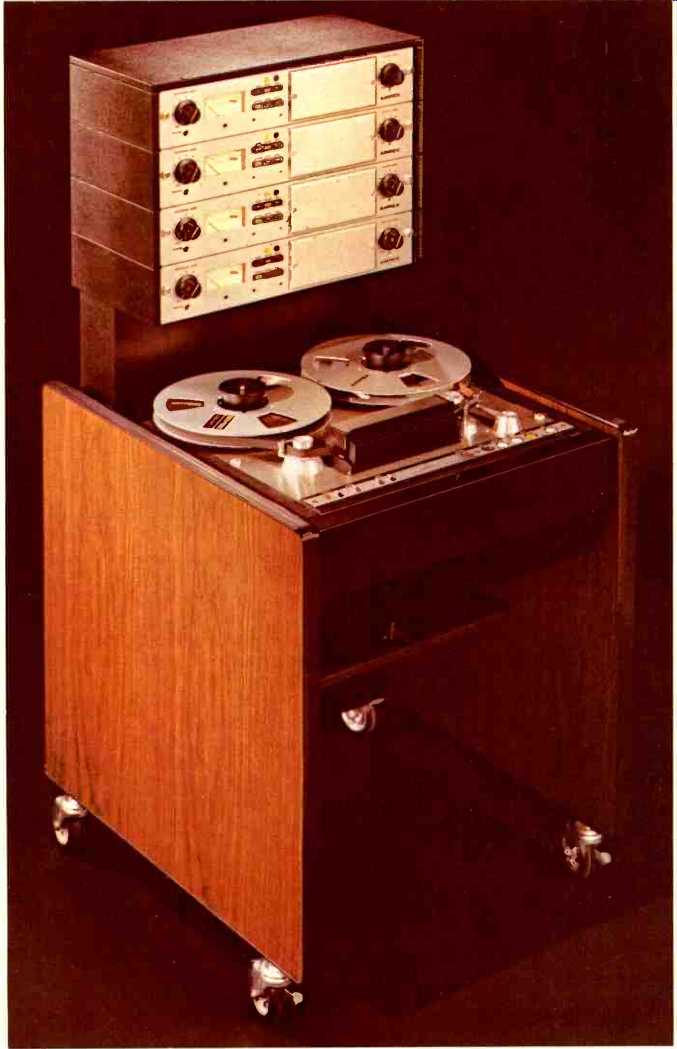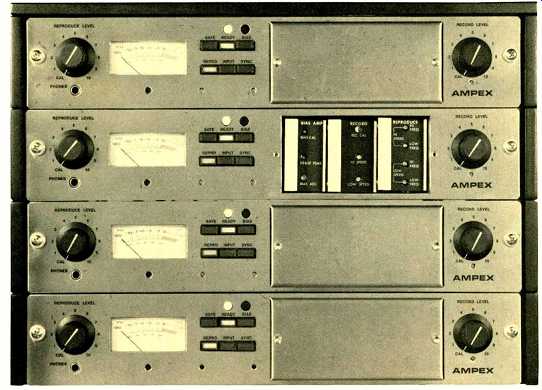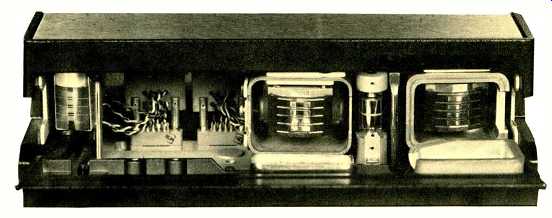
FOR THE PAST SEVERAL months I have had the privilege of using the production
prototype of the new Ampex AG-440C professional audio recorder (shown above).
The model furnished to me was the 440C-4, a four-channel recorder using
1/2-in. tape. I have been using its illustrious predecessor, the 440B,
in the same configuration for some years now, so I had a handy reference
for comparison. After end less hours of testing, probing, measuring, after
trying to confuse and abuse the tape transport logic, and after "nit
picking" my
way through the various electronic and mechanical parameters, I can state
unequivocally that the Ampex 440C is a "state-of-the-art" recorder
in the truest sense of that overworked term and the finest professional
tape machine I have ever used.
Progress in the world of professional audio is generally evolutionary in nature, and so it is with the Ampex 440C. The truly revolutionary tape recorder will utilize digital techniques, and in spite of some recent progress, it still appears to be a long time off in the future. There are, to be sure, some important innovations in the Ampex 440C. For the most part however, it is the updating and painstaking refinements of existing performance and maintenance features that makes the 440C such a high quality tape recorder.
Basic to the 440C and all Ampex professional tape recorders is the very heavy die-cast and precision-milled top plate. Die casting is expensive, but if you are to have the tape transport components rigidly mounted in an accurate and unyielding plane, this is the way to go. This heavy plate makes possible the interchange of tape head assemblies for quarter-inch and half-inch tape. There is a finely milled area on the top plate, with two machined guide pins and two screw holes.
The heads are contained in a cast housing, the base of which has been milled and holes drilled which align perfectly with the machined pins, and which accept screws and lock washers to secure it to the top plate. The leads from the heads terminate in a flat fiberglass board and are connected to a series of pins. The board/pin assembly plugs into female receptacles which are mounted at the back end of the milled head area on the top plate. This arrangement makes the 440C available with full-track, half-track, two-track and four-channel heads for quarter-inch tape, and for a four-channel head with half-inch tape. There is a special Ampex 440C-8, which is an 8-track version utilizing one-inch tape. To accommodate both the quarter-and half-inch tape, the tape guides at the supply and take-up sides of the recorder have a clever spring-loaded mechanism, which, when pulled upwards and given a half turn, presents a choice for either tape width. Mounted on the head area on the top plate and coming up into the head casting is the scrape flutter filter. The filter is mounted in jeweled bearings as in earlier models of the 440, but in the new 440C, the idler has a groove cut into it at mid-point which is claimed to further reduce friction.
The half-inch head assembly of the 440C features sapphire tape guides which reduce tape skew to a very low figure and translate into greater phase shift stability as well as high frequency amplitude stability. This phase shift stability is extremely important in multi-channel head configurations. The heads in the 440C are of a new design, with thinner laminations giving less iron loss. There is a new adjustment in the reproduce electronic module for head resonance which compensates for gap loss. These improvements in the heads and in the associated electronics result in a remarkable frequency response of 30 Hz to 25 kHz ± 2 dB at 15 ips. To round out the features in the head housing, the automatic tape lifters come up through the top plate into the housing and they may be over ridden manually, electrically or by remote control for cueing or editing.
The Ampex 440C may be ordered with the hysteresis synchronous motor common to previous models, but in my opinion most users should opt for the d.c. motor with servo control.
-----------------------------

above: Manual controls on the AG-44C include indicator pushbuttons used for operating functions. Calibrate positions have been incorporated on the reproduce and record level controls for easier adjustment and maintenance.

above: Close-up of the head assembly. AG-440C recorders feature sapphire guide in their tape guidance systems.
----------------------------------
The 440C I had was so equipped and to me this is one of the most worthwhile and significant features of the new recorder. The capstan servo system consists of a d.c. power supply, a motor drive amplifier, a high torque, direct drive d.c. motor with a magnetic tachometer, crystal reference oscillator, a selectable frequency divider, a phase comparator and a low-pass filter. Except for the d.c. power supply and the motor, all electronic circuitry is on a printed circuit board mounted inside the servo chassis at the rear of the recorder. This is a position servo and, in essence, the tachometer pulses are compared with the selected reference frequency and any frequency difference between them causes the comparator to produce a corresponding output voltage.
Thus, tape speed is entirely independent of power line voltage and frequency variations. There is a provision to use an external reference oscillator which in special applications affords tape speeds from 3 ips to 45 ips. Another advantage of the servo system is that it doubles the number of speeds avail able on the 440C. By a simple change of jumper pins on the servo printed circuit board, you may choose speed pairs at: 3 3/4 / 7 ½; 7 1/2/15; or 15/30 ips.
Of course, you must also change the record and playback equalization cards in the electronics for the speeds you choose. The servo motor system affords excellent tape speed accuracy and stability. There is no drift, and the wow and flutter figures are impressive.
Unweighted NAB is 0.05% at 30 ips, 0.06% at 15 ips, 0.08% at 7 1/2 ips, and 0.1% at 3 3/4 ips. High torque assures fast start-up time. When necessary, an instant start, with no delay whatsoever, can be achieved by pressing both the STOP and PLAY buttons simultaneously, then releasing the STOP button, at which time the capstan is up to speed. A relay, which can be plugged into the servo control chassis, sets up a condition where the capstan will not start until the tension arm is in the ON position and the TAPE button is depressed. This is of value in broadcasting work where long stand-by periods often occur.
As in previous 440 models, tape motion is controlled by pushbutton solenoid operation. Response is virtually instantaneous, and with no clicks or pops either through your loud speakers or on the tape. In the 440C, motion sensing has been added. A tacho meter on the supply-reel table furnishes information to an LED/photo transistor sensor. With this system, it is possible to be at full speed in the fast forward or rewind modes, press the PLAY button, and the tape will slow and then stop and go immediately into play mode. This system is also fail safe ... any interruption of power, even when running in fast forward or rewind, will simply stop the reels without spilling miles of tape.
For easy serviceability, the record control and transport logic circuitry are on plug-in etched boards. In addition to the fully opening head gate, editing is simplified with a feature that relaxes the brakes without the need of holding up the takeup tension arm, as in earlier Model 440 units. Tape may be spilled without the tape being threaded through the tension arm and without movement of the takeup reel.
A small but important new feature on the transport is that when the recorder is in the standby mode, tape will not rub on the capstan shaft.
Now that we have covered the heads and the 440C transport, let's take a look at the electronics. New on the 440C are calibrate positions for re produce and record controls. When turned fully counterclockwise, the controls click into a detent position.
While in this position, access holes to screwdriver gain adjusts (located underneath and to the left of the VU meter on the electronics module for reproduce, and a similar one underneath the record control) permit the setting of various standards. For example, in conjunction with my Dolby A361 units, I adjust the reproduce calibrate control for Dolby level at 0 VU.
All plug-in circuit cards now have gold-plated contacts for greater reliability. Overall improvement in the electronics have resulted in improved signal-to-noise ratios and less hiss in standby mode. Sel-Sync response has been improved at 15 ips, now typically 30 Hz to 12 kHz ± 2 dB. Sel-Sync signal-to-noise ratio is now equal to reproduce S/N. In the 440B, Sel-Sync gain adjustments had to be made from the rear and were a real pain. Now the adjustment is on the front panel of the electronics. Also, automatic switching has been incorporated in the Sel Sync mode. When a channel being re produced in Sel-Sync is put into record, the output switches from monitoring Sel-Sync to monitoring input. Instead of rotary switches for recorder functions as input, repro, ready and Sel-Sync, there are indicator pushbuttons with colored shadow masks. Meter sensitivity is now easily selectable by switch from +8, used mainly in broadcast work, to +4, the standard of the recording industry in this country. A minor point, but good thinking, is that the VU meters are now flush with the electronics modules to minimize breakage. Another small point, but again helpful if you have either struggled with a small Allen wrench (or didn't have the right size), is that the access panel to the circuit cards is now fastened with knurled coin-slot screws. Record and ready lamps are now replaceable from the front instead of at the rear, as on previous 440 units.
After five or six hours of use, the 440B recorders used to get a pretty warm top plate. In the 440C, an auto transformer has replaced a power transistor, so this is no longer a problem.
The usual spate of accessories are available for the 440C, including remote control. An unusual one, however, available only with servo motor units, is the sync lock, which provides constant lip sync with film or video, or sync with another recorder.
That is pretty much the make-up of the new Ampex AG-440C. The specifications resulting from all these various improvements are very impressive. As noted previously, frequency response at 15 ips, using Ampex 406 tape, was ± 2 dB, 30 Hz to 25 kHz; at 7 1/2 ips + 1/-2 dB, 30 Hz to 18 kHz; 3 3/4 ips was + 1/-2 dB from 30 Hz to 7.7 kHz.
At the 30 ips speed, the response was ± 2 dB, 50 Hz to 20 kHz. My frequency response and alignment tape only goes out to 20 kHz, but I measured 16 kHz as exactly flat, while the 20 kHz was down but a half of a dB! Signal-to-noise ratio for full track 440C recorders using the ASA weighted curve is claimed to be an awesome -73 dB! With the same curve, the 440C four-channel unit I used was rated at -68 dB at 7 1/2 ips, and -66 dB at 15 ips.
With Dolby A361 units adding another 10/15 dB, this is truly astonishing. I made various types of recordings, including some live material through a mixer, and in all cases, noise ceased to be a factor.
Using the Ampex 440C was truly a delight. All controls are logically disposed and easy to use. The operation of the recorder becomes virtually instinctive. Tape handling is quite out standing, very positive starts and stops, extremely smooth spooling, including while in fast forward and rewind modes.
The sound of my half-inch Dolby A quadraphonic master tapes was "hound's tooth" clean. I changed heads from the four-channel half-inch to the two-channel head from my Ampex 440B recorder.
Because the heads were not of the new design, the frequency response run on my alignment tape wasn't as impressive, but being down 2 1/2 dB at 20 kHz ain't exactly suffering! All in all, my experience with the Ampex 440C bolsters my opinion that if you can afford the best ... this is unquestionably it.
(Audio magazine, Apr. 1974; Bert Whyte)
= = = =